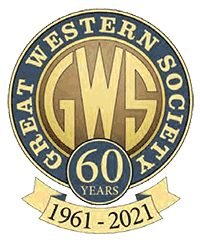Restoration of Radstock North Box
Radstock North Signalbox was purchased by the Bristol Group of the Great Western Society in 1975 and transported to Didcot Railway Centre.
Over the next fifteen years it was placed on a new brick base, restored and a working GWR style signalling installation, complete with level crossing, constructed.
The Move to Didcot
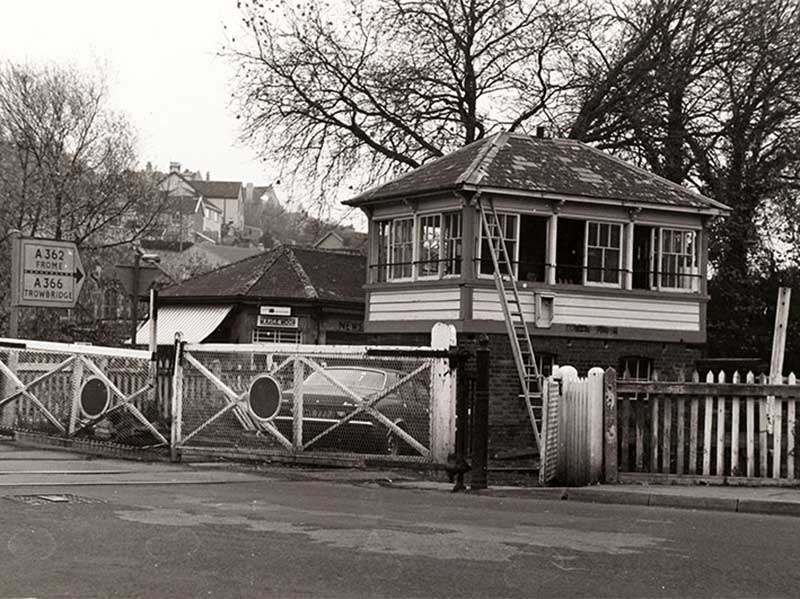
Radstock (GW) Box in Autumn 1975. A Bristol Group working party begins preparations for removal of the box.
Photo: A R Hook (GWS Collection)
It would be fair to say that the Didcot signalling project started in Radstock as it began with the simple idea of preserving a signal, which was successfully achieved with the removal of some signal posts and fittings from Radstock in May 1972. Ambitions then expanded and with the approval of the GWS Council the search for a signalbox commenced. Various signalboxes were considered but only Radstock North proved suitable.
Bristol Group secretary, John Lakey, wrote to British Rail, in November 1973, and was given first refusal when the box became available. So the serious thinking of how to remove and transport a wooden structure 18 ft x 12 ft by 10 ft high, weighing 6 tons began. All went quiet again for a year, despite John's regular letters to British Rail, and Derek Fear's visits to the Area Manager at Westbury, so in August 1975 John also wrote to Avon County Council asking if any road improvements were going to take place at the Radstock level crossings, as various rumours had been doing the rounds for the past year. This seemed to provoke some action, as in September Derek Fear and John Lakey were invited to a meeting between British Rail and Avon County Council at which it was agreed that British Rail would release the box to the Group within two weeks, and the County Council would buy the land surrounding it to carry out road improvements.
Plans were made to prepare the box for movement, as the site had to be cleared by the end of November, leaving only eight weeks. By the time the next Committee meeting was held at the end of September a letter had been received from British Rail officially offering the box and one level crossing gate with post for £54. So a cheque was sent off, and about a week later the sale was confirmed.
The first working party took place on Sunday 12th October 1975 after which, working parties were organised each Sunday, and some Saturdays as well. Four members, more crazy than the rest spent a cold damp night of November 5, drilling a series of holes for bolts and screws to secure strengthening brackets for the four corners of the structure, by the light of a Tilley lamp. During these working weekends, the locking frame was bolted to its supporting wooden beams with coach screws. The inner and outer leading-off beds were disconnected and removed. All the point and gate rodding, together with the cranks, the box steps and the level crossing gates were recovered, and a telegraph pole removed. The inside of the structure was reinforced with scaffolding, and the guttering and bottom row of slates removed and other slates made secure. The vent on the roof was also removed, as the overall height had to be less than 14 ft to travel without a special movement order.
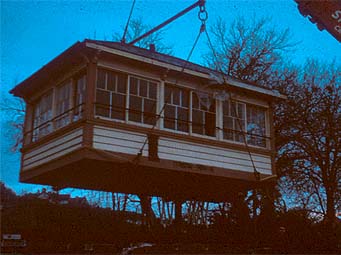
Finally on Sunday 23rd November the 22ton crane arrived, at 7:00 am and was positioned on the track bed, slightly to one side of the box. By 7.30 the first low-loader was positioned in front of the box, adjacent to the crane. The 14ft long lifting beams of tubular steel, 6 inches in diameter, were positioned under the structure to support the main 5x4 inch timbers each side. The crane's jib was extended to about 35 ft, the overhead stretcher bar, chains and shackles connected to the lifting beams, and the slack taken up.
A Harlech Television cameraman, Radio Bristol interviewer and various newspaper reporters had arrived, to be looked after by Richard Sweet, the Group’s publicity officer.
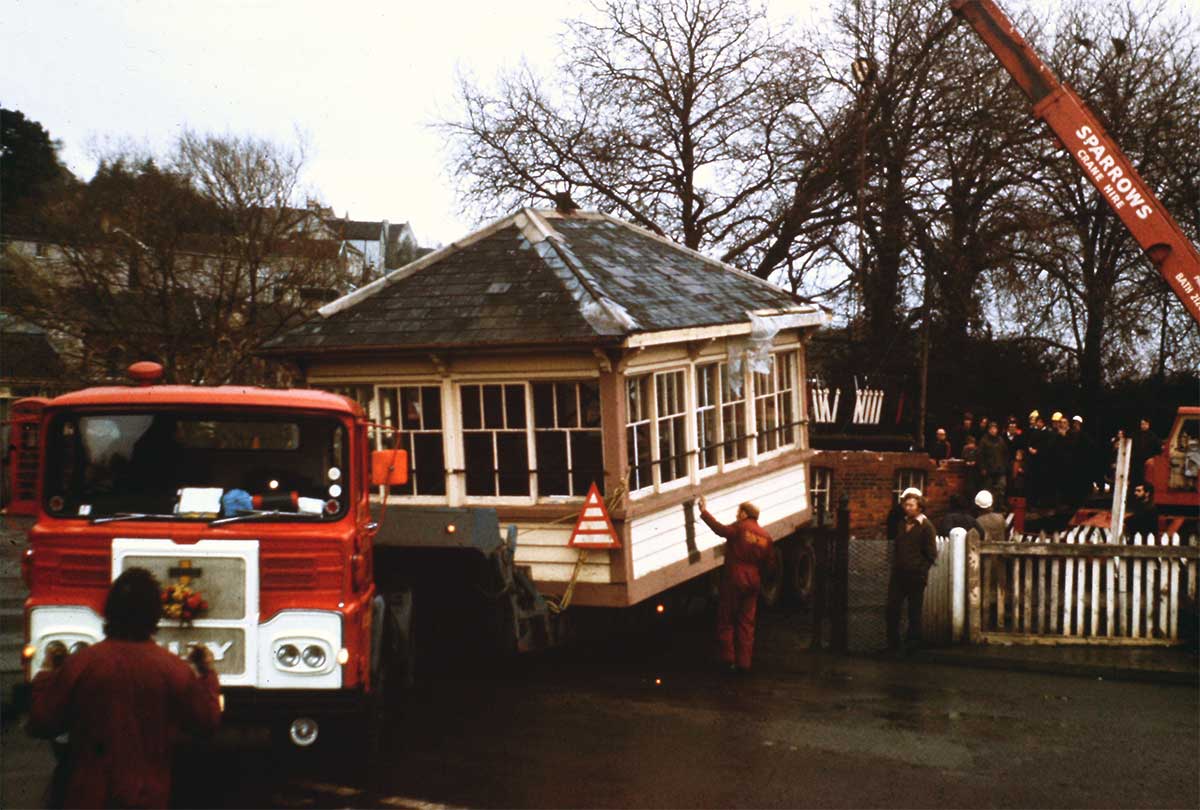
V M Hook 23-Nov-1975
John Lakey, Derek Fear and Kevin Evans were up in the box ready to knock out the four spacing blocks, two at each end, between the floorboard beams and the locking frame. The crane took the weight of the box and the blocks hammered out, and then they got out - fast! The structure was gently lifted off its brick base and, as expected, there were no bolts or securing devices of any kind.
Once clear of the brickwork, the structure was lifted a further five feet to clear the levers. The steps, gate wheel assembly, wicket gates and porch-supporting rails also found space on this low-loader which was then parked outside the Waldegrave Hotel. The brick walls were demolished as soon as the structure was lifted, since these were then unsafe. The locking room door, window frames and specially shaped blue engineering bricks were recovered during demolition.
The crane now swung into position above the locking frame, while the second low-loader backed onto the trackbed. Because of its forty feet long bed, however, the power unit partially blocked the main road, and a very co-operative police officer had to guide the increasing volume of traffic around it.
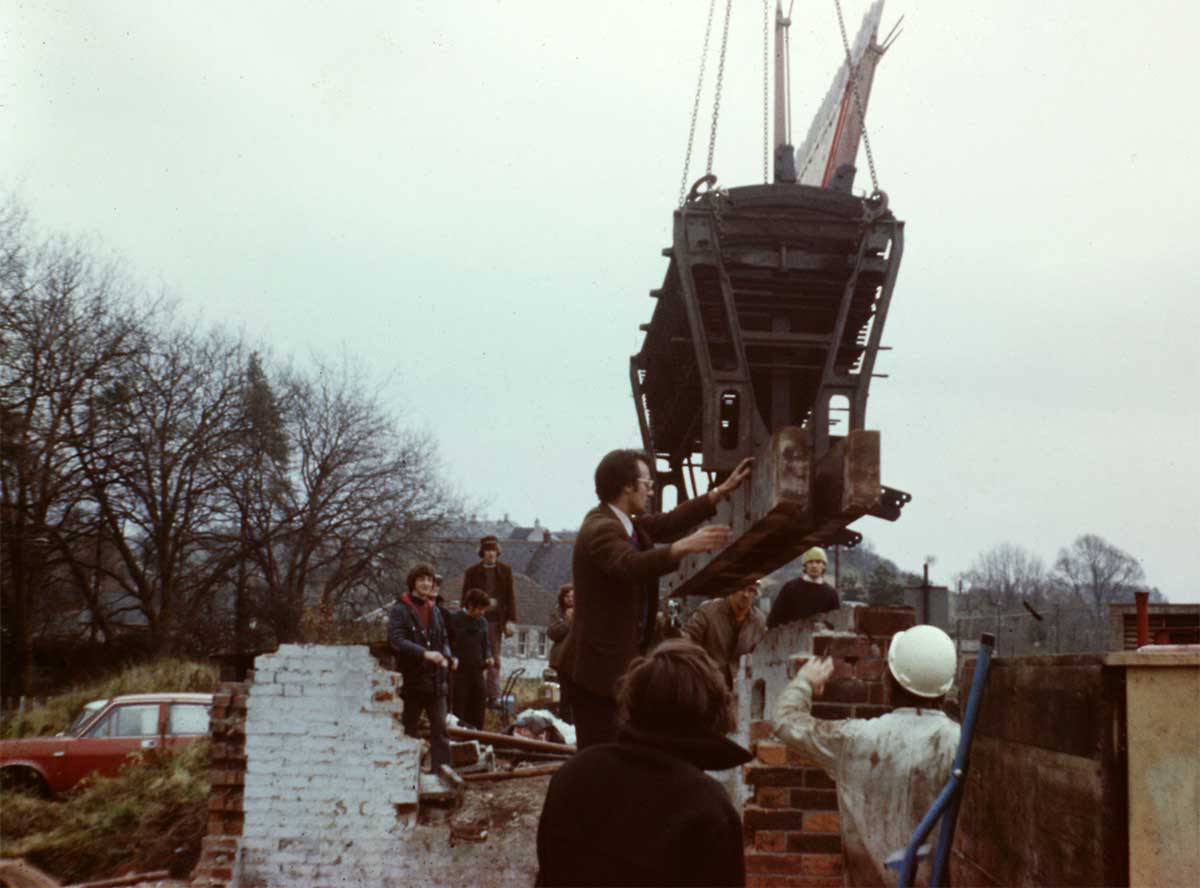
V M Hook 23-Nov-1975
The lifting chains were attached to the end brackets of the frame, which was lifted complete with its wooden supporting beams, giving a total weight of two tons. It was swung across and laid on its side on the long bed of the second low-loader.
Soon after, at about 10.30, the low-loader carrying the structure set off, with an Avon and Somerset Police escort, on its four hour journey to Didcot at a speed of 15-20 mph.
Three cars with Bristol Group members inside accompanied it, while the party who were going to stay at Radstock to clear up the site carried on loading the second vehicle. The four level crossing gates and one post, leading-off beds with associated rodding and cranks, and the various timbers from inside and outside the now demolished box were lifted onto it. This load was tarpaulined down to prevent items falling off, as this vehicle did not have any speed restrictions.

V M Hook 23-Nov-1975
The signal box structure arrived in the Didcot provender yard at about 2.30pm, by which time the first low-loader to arrive was half unloaded, with the locking frame about to be lifted off onto the rail wagon, together with all the lengths of point rodding. Suitable packing was put onto the other rail wagon and the lifting bars positioned for the locally hired crane to lift the structure. It overhung the rail wagon by two feet either side when loaded, but British Rail had been alerted for an out of gauge load.
The steps and crossing gate wheel assembly were loaded into the Asmo and Siphon G, together with other small items, and finally, by 5.30, the four gates were secured to a further wagon and the job was complete.
The description of the move above, is an adapted and much shortened version of an article: ‘Radstock West Goes East’ by Kevin Evans. Great Western Echo - No.55. Spring 1976 pp, 10-13.
Restoration

M Minchin 1975
Unfortunately, the signalbox top was too heavy to be lifted by any cranes available at Didcot so all moves had to be made by the time honoured method of jacking and packing.
On arrival it was stored, on suitable packing timbers, adjacent to the boundary fence roughly on the opposite side of the (at that time, still to be constructed) branch demonstration line, from its current home.
Obviously the first stage in the reconstruction was the laying of suitable concrete foundations. On this foundation a new brick base was constructed using some excellent quality engineering bricks which were kindly donated to the project.
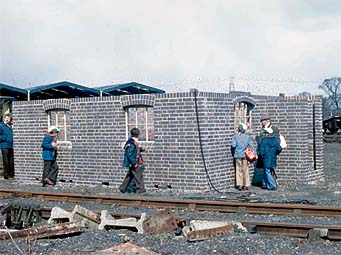
The new base incorporated the cast-iron window frames, specially shaped window sill bricks, and the doors and door frames, which had been recovered from Radstock along with the box top. This work took place throughout 1976 and the completed brickwork is seen in April 1977.
Note that the track in the foreground is a temporary access track from the shed area, which was later removed.
Once the base was complete the box top had to be moved to a position adjacent to the base, raised to the correct height, and then moved into its final position.
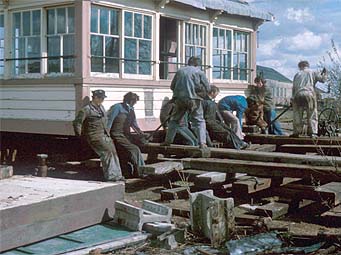
Again, this was achieved using purely manual methods, involving boiler tubes used as rollers, crowbars, screw and hydraulic jacks, enormous quantities of packing timber, and the good traditional sweating and swearing required on such occasions. It actually took two days work in April/May 1977 to move the box from its temporary storage location, to its final home on top of the brickwork, the final move being completed by some of the Manpower Services Commission brawn then on site.
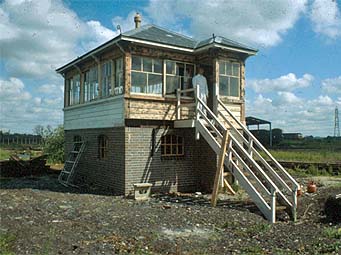
The woodwork making up the structure of the box top was in remarkably good condition, and very few repairs and replacements were needed. It was however necessary to build a new set of box steps as the box was no longer accessed from a station platform in its new location. Other work at this stage involved fitting new guttering, and stripping all the woodwork for repainting.
Once the repairs were completed, painting could commence, together with some final touches, such as the (electrified) oil lamp and the fire buckets.
The external work was declared complete on May 7th 1979 (GWS NN 111), and the box found itself standing in glorious isolation, with no tracks passing near it, and frankly looking somewhat out of place.
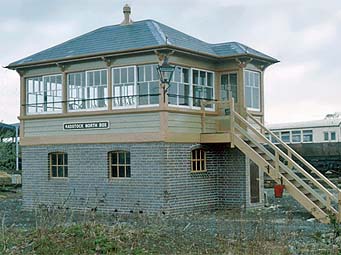
In some ways this was where the real challenge began. The interior restoration was carried out and the original lever frame installed and re-locked. The re-locking was declared complete on 7th December 1980 after some 15 months of work (GWS NN 123).
However before the box could reasonably be considered operational it was, of course, necessary to install some things for it to operate, specifically a level crossing, and some points and signals. This work was sufficiently advanced, in May 1985, for the box to be operated for the first time as a crossing box; controlling the crossing, Radstock siding point, and one signal protecting the crossing in each direction.
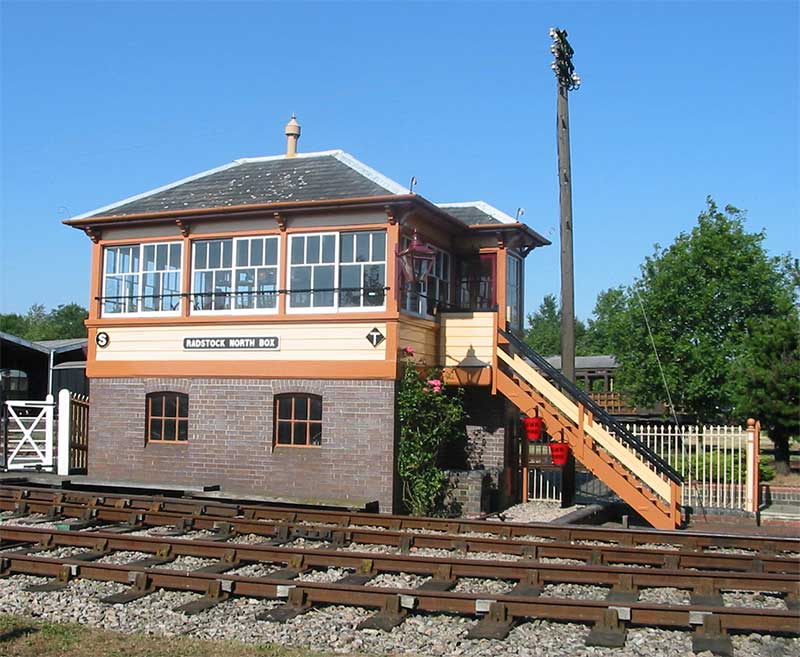
Since then work on installing other signalling equipment and features has continued until the box is fully operational. Work has also continued on landscaping, fencing etc. to improve the look of the Great Western scene. The box, as seen here, now looks as though Didcot has been its home for the last hundred years. (It is a sobering thought, however, that in one form or another Didcot has now been its home for more than 40 years!)
